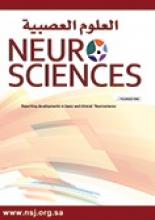Review ArticleReview Article
Open Access
Review on myelomeningocele management and its current status in Saudi Arabia
Ibrahim M. Alnaami and Eman G. Alayad
Neurosciences Journal January 2019, 24 (1) 5-10; DOI: https://doi.org/10.17712/nsj.2019.1.20180169
Ibrahim M. Alnaami
From the Department of Neurosurgery (Alnaami, Alayad), Asir Central Hospital, and from the Department of Neurosurgery (Alnaami), Abha Maternity and Children Hospital, Abha, Kingdom of Saudi Arabia
MD, FRCSCEman G. Alayad
From the Department of Neurosurgery (Alnaami, Alayad), Asir Central Hospital, and from the Department of Neurosurgery (Alnaami), Abha Maternity and Children Hospital, Abha, Kingdom of Saudi Arabia
MD.
References
- ↵
- Ware AL,
- Kulesz PA,
- Juranek J,
- Cirino PT,
- Fletcher JM
- ↵
- Werhagen L,
- Gabrielsson H,
- Westgren N,
- Borg K
- ↵
- Seidahmed MZ,
- Abdelbasit OB,
- Shaheed MM,
- Alhussein KA,
- Miqdad AM,
- Khalil MI,
- et al.
- ↵
- Magbool G,
- Al Mulhim I,
- Uduman SA,
- Al Umran K
- ↵
- El-Awad Mel-H,
- Sivasankaran S
- ↵
- Asindi A,
- Al-Shehri A
- ↵
- Safdar OY,
- Al-Dabbagh AA,
- Abuelieneen WA,
- Kari JA
- ↵
- AlShail E,
- De Vol E,
- Yassen A,
- Elgamal EA
- ↵
- Greene ND,
- Copp AJ
- ↵
- Al Rakaf MS,
- Kurdi AM,
- Ammari AN,
- Al Hashem AM,
- Shoukri MM,
- Garne E,
- et al.
- ↵
- Al-Akhfash AA,
- Abdulla AM,
- Osman AM,
- Abdulgafar JI,
- Almesned AA
- ↵
- Salih MA,
- Murshid WR,
- Mohamed AG,
- Ignacio LC,
- de Jesus JE,
- Baabbad R,
- et al.
- ↵
- Arth A,
- Kancherla V1,
- Pachón H,
- Zimmerman S,
- Johnson Q,
- Oakley GP Jr.
- ↵
- Lo A,
- Polšek D,
- Sidhu S
- ↵
- Salih MA
- ↵
- Rofail D,
- Maguire L,
- Kissner M,
- Colligs A,
- Abetz-Webb L
- ↵
- Grosse SD,
- Berry RJ,
- Mick Tilford J,
- Kucik JE,
- Waitzman NJ
- ↵
- Kumar J,
- Afsal M,
- Garg A
- ↵
- Shapiro GK
- ↵
- Al-Matary A,
- Ali J
- ↵
- Adzick NS
- ↵
- Heuer GG,
- Adzick NS,
- Sutton LN
- ↵
- Antiel RM,
- Collura CA,
- Flake AW,
- Johnson MP,
- Rintoul NE,
- Lantos JD,
- et al.
- ↵
- Antiel RM
- ↵
- Antiel RM,
- Adzick NS,
- Thom EA,
- Burrows PK,
- Farmer DL,
- Brock JW 3rd.,
- et al.
- ↵
- Brown SD,
- Feudtner C,
- Truog RD
- ↵
- Kulkarni AV,
- Drake JM,
- Kestle JR,
- Mallucci CL,
- Sgouros S,
- Constantini S
- ↵
- Elbabaa SK,
- Gildehaus AM,
- Pierson MJ,
- Albers JA,
- Vlastos EJ
- ↵
- Jackson EM,
- Schwartz DM,
- Sestokas AK,
- Zarnow DM,
- Adzick NS,
- Johnson MP,
- et al.
- ↵
- Johnson MP,
- Bennett KA,
- Rand L,
- Burrows PK,
- Thom EA,
- Howell LJ,
- et al.
- ↵
- Wataganara T,
- Seshadri S,
- Leung TY,
- Matter C,
- Ngerncham M,
- Triyasunant N,
- et al.
- Zuccaro G
- ↵
- Van Calenbergh F,
- Joyeux L,
- Deprest J
- ↵
- McLone DG
- ↵
- Epstein NE,
- Rosenthal AD,
- Zito J,
- Osipoff M
- ↵
- Parent AD,
- McMillan T
- ↵
- Machado HR,
- Santos de,
- Oliveira R
- ↵
- Radmanesh F,
- Nejat F,
- El Khashab M,
- Ghodsi SM,
- Ardebili HE
- Tuli S,
- Drake J,
- Lamberti-Pasculli M
- Teo C,
- Jones R
- ↵
- Warf BC,
- Campbell JW
- ↵
- Jimenez-Gomez A,
- Castillo H,
- Burckart C,
- Castillo J
- ↵
- Santos MM,
- Rubagumya DK,
- Dominic I,
- Brighton A,
- Colombe S,
- O'Donnell P,
- et al.
- ↵
- Mnguni MN,
- Enicker B,
- Madiba TE
- ↵
- Rei J,
- Pereira J,
- Reis C,
- Salvador S,
- Vaz R
- ↵
- Chakraborty A,
- Crimmins D,
- Hayward R,
- Thompson D
- ↵
- Tamburrini G,
- Frassanito P,
- Iakovaki K,
- Pignotti F,
- Rendeli C,
- Murolo D,
- et al.
- ↵
- Strömfors L,
- Wilhelmsson S,
- Falk L,
- Höst GE
- ↵
- Brustrom J,
- Thibadeau J,
- John L,
- Liesmann J,
- Rose S
- ↵
- Dicianno BE,
- Kurowski BG,
- Yang JM,
- Chancellor MB,
- Bejjani GK,
- Fairman AD,
- et al.
- ↵
- Fieggen G,
- Fieggen K,
- Stewart C,
- Padayachy L,
- Lazarus J,
- Donald K,
- et al.
- Kaufman BA,
- Terbrock A,
- Winters N,
- Ito J,
- Klosterman A,
- Park TS
- Kinsman SL,
- Levey E,
- Ruffing V,
- Stone J,
- Warren L
- Houtrow A,
- Dicianno BE
- De Coppi P
In this issue
Review on myelomeningocele management and its current status in Saudi Arabia
Ibrahim M. Alnaami, Eman G. Alayad
Neurosciences Journal Jan 2019, 24 (1) 5-10; DOI: 10.17712/nsj.2019.1.20180169
Jump to section
Related Articles
- No related articles found.
Cited By...
- No citing articles found.





